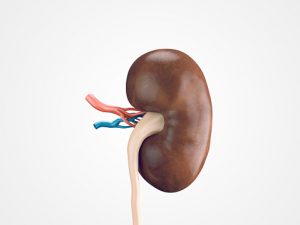
Renal infarction definition
A renal infarct is caused by a reduction of flow to one or both kidneys and can be caused by a blockage of the blood vessel leading to the organ. However, a direct blockage of blood is not the only way for infarction to occur, as in states where blood oxygenation is poor or in cases of congestive heart failure, the structures that are responsible for blood supply may be compromised.
Any cause of kidney injury leading to cell death may result in hematuria—blood in the urine. This is not seen by the naked eye initially, as microscopic levels may be present first. Injury to the kidney may also result in flank pain—pain that is located on the lower back.
Renal infarction risk factors
Risk factors that can increase the odds of developing renal infarction include:
- Atrial fibrillation – irregular heartbeat
- Previous infarct
- Pulmonary embolus
- Valvular or ischemic heart disease
- Bacterial endocarditis
- Antiphospholipid syndrome
- Polycythemia Vera
- Factor V Leiden mutation
- Antithrombin III deficiency
- Protein C and S deficiency
Renal infarction causes and symptoms
The majority of renal infarctions occur due to a thromboembolic event, or clots. This phenomenon can occur in a multitude of ways, from disorders in clotting mechanisms to physical trauma leading to clot development. The following are some of the causes of renal infarction:
Due to obstruction of kidney blood flow:
- Renal artery stenosis
- Renal artery embolism
- Atrial fibrillation
- Mitral valve disease
- Foramen ovale
- Renal artery thrombosis
- Renal artery aneurysm
- Renal vein thrombosis
Low cardiac output states leading to low kidney blood supply:
- Congestive heart disease
- Hypotension
- Cardiac surgeries
Symptoms experienced during an issue of renal infarction may be non-specific and is therefore diagnosed later than it should be. Renal infarct may be the product of another underlying disease, further confounding the presentation. But there are a couple of specific kidney-related symptoms that are as follows:
- Epigastric pain: Mostly observed over the epigastric dermatome and often radiates to the lower back either on the right or left side depending on the side affected.
- Flank pain: Experienced as very severe stabbing pain that is localized over the flank. Pain radiates to the lower back either on the left or right side.
- Abdominal tenderness: When the abdomen is palpated in the upper areas, severe pain can be appreciated over the epigastrium. This abdominal pain is not associated with guarding or rebound pain.
Renal infarction diagnosis
Often times, when renal infarction happens acutely, it is in the emergency room due to the patient feeling severe pain in the lower back and abdominal area. Once a brief history and physical exam are taken, imaging tests will confirm that a renal infarct has actually taken place. The following are some tests that are likely to be done in a suspected case of renal infarction:
- CT or MRI scan: Gives a detailed look at the arteries supplying the kidneys
- Urinalysis: Will help determine if blood is present in the urine as well as protein and white blood cells
- Blood test: Will check to see if all blood values are in normal ranges, looking for signs of anemia
- Doppler ultrasound: May be able to reveal any calcification or renal aneurysms
- Electrocardiogram and Echocardiogram: used to see the electrical activity of the heart for the diagnosis of abnormalities in function and to view images of the heart directly, respectively.
- Colonoscopy: performed by inserting long tube with a camera on the end into the colon via the anus. The procedure can be useful for showing signs of ischemic bowel disease
Treating renal infarction
- General principles: because those with problems with the kidneys often have resulting high blood pressure, a prescription of antihypertensive medication is often warranted. High blood pressure caused by increased renin that presents in kidney failure. If thromboembolism is suspected to be a risk, the use of anticoagulation therapy may be warranted. If atrophy of the kidney has not yet occurred, reperfusion therapy should be considered.
- Anticoagulation: commonly implemented via intravenous heparin followed by oral warfarin. Heparin is then discontinued once the INR is stable, and continued on warfarin. The goal INR is to prevent renal infarction due to a clot is between 2.0 and 3.0. However, this range may need to be modified depending on the cause.
- Percutaneous endovascular therapy: a procedure that directly open blood vessels in the kidney to increase perfusion. It can be utilized for thrombolysis, thrombectomy, and/or angioplasty with or without stent placement.
- Thrombolysis and thrombectomy: treatments to dissolve dangerous clots or to surgically remove a dangerous clot, respectively.
- Angioplasty: a procedure that opens the blocked blood vessel with or without stent placement. This may help improve blood pressure.
- Surgery: often reserved or serious cases of renal infarct such as in patients with traumatic renal artery occlusion and embolic renal artery occlusion. This involves surgically removing the obstruction.
Prognosis of renal infarction
The approximate prognosis of either treated or untreated renal infarction is uncertain. The condition occurs in patients who have other condition associated with being diseased and at risk of dying, such as diffuse atherosclerotic disease and atrial fibrillation. Conditions such as these may embolize other organs besides the kidneys, including the brain causing a stroke.
However, a previously done retrospective study of 44 patients with atrial fibrillation, 38 of which were treated with anticoagulation therapy with the remaining 6 not having it. They found that 61 percent had normal renal function, 13 percent had mild renal impairment, 18 percent had significant renal impairment, and 8 percent were dialysis dependent. Additionally, 5 patients died during the first month after diagnosis, with 11 patients having repeat thromboembolic events.
Related: Renal diet: Foods to eat and avoid for kidney failure